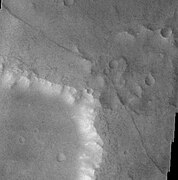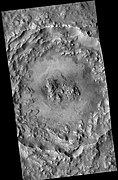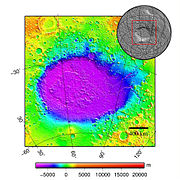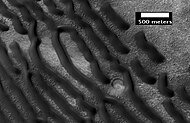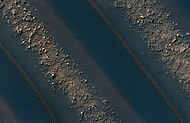火星礦石資源
火星上可能蘊藏有對未來定居者非常有用的礦石[1][2],豐富的火山地貌和遍佈的撞擊坑是多種礦石的有力證據[3]。雖然在火星上尚未找到任何值得花高昂成本運回地球的東西,但未來定居者從火星上獲得的礦石越多,也就越容易在那裏建立棲息地[4]。
礦床的形成
[編輯]礦床是在大量熱量的幫助下形成的,在火星上,熱量可能來自地下移動的熔岩和隕石撞擊。地下液態岩石稱為岩漿,當岩漿進入地下洞室,在歷經數千年緩慢的冷卻中,較重的元素會下沉,包括銅、鉻、鐵和鎳等元素會沉積在底部[5]。岩漿熾熱時,許多元素都可自由移動,但隨着冷卻的開始,這些元素則相互結合形成化合物或礦物。由於有些元素不容易結合成礦物,所以當幾乎所有其他元素都結合成化合物或礦物後,它們仍單獨存在,這些剩下的元素稱為不兼容元素[6],其中一些對人類非常有用,如鈮,一種用於製造超導體和特種鋼的金屬,以及用於電視顯示器和節能發光二極管燈泡的鑭、釹和銪等[7]。在岩漿團冷卻並大部分凍結或結晶成固體後,會殘留少量液態岩石,這種液體中含有鉛、銀、錫、鉍和銻等重要物質[8]。有時岩漿室中的礦物非常熾熱,以致處於氣體狀態,另一些則與液體溶液中的水和硫混合。氣體和富含礦物質的溶液最終進入裂縫,成為有用的礦脈。礦石礦物,包括不相容元素,在熱溶液中保持溶解狀態,當溶液冷卻時則結晶出來[9],由這些熱溶液形成的沉積物稱為熱液礦床,世界上一些最重要的金、銀、鉛、汞、鋅和鎢等礦床就是以這種方式形成的[10][11][12]。南達科他州北部布拉克山上幾乎所有的礦山都形成於熱液中的礦物沉積[13]。當大量岩漿冷卻時,通常會產生裂縫,因為岩漿冷卻時會收縮硬化。裂縫出現在凍結的岩漿體和周圍岩石中,因此礦石可沉積在附近任何一種岩石中,但礦石礦物必須先通過熔融岩漿體來濃縮[14]。
路易斯安那州立大學進行的研究發現,埃律西昂火山周圍有不同類型的火山物質,表明火星可能有岩漿演化,這就有可能為火星上未來的人類找到有用的礦物[15][16]。
火星上的熔岩
[編輯]火星上有許多巨大的火山,表明過去大片區域都非常炎熱。奧林帕斯山是太陽系中最大的火山,而其它較小火山中的一座—什洛尼爾斯火山丘高度也接近地球上的珠穆朗瑪峰。
-
顯示奧林帕斯山地區有數座大型火山
-
熱輻射成像系統顯示的熔岩流,注意邊緣的形狀。
有強力證據表明,火星上的熱源普遍以岩脈的形式出現,這表明岩漿在地下流動,像牆壁一樣穿過岩層[17]。在某些情況下,火星上的岩脈因侵蝕而暴露出來。
-
HiWish計劃下高解像度成像科學設備顯示的阿拉伯高地的岩脈,這些筆直的特徵可能表明未來定居者在那裏能找到有價值的礦床,比例尺為500米。
-
HiWish計劃下高解像度成像科學設備顯示的陶瑪西亞區可能的岩脈,岩脈中可能沉積了價值的礦物。
-
HiWish計劃下高解像度成像科學設備顯示的奧克夏沼區可能的岩脈。
-
HiWish計劃下高解像度成像科學設備顯示的可能岩脈,圖像位於雅庇吉亞區。
-
HiWish計劃下高解像度成像科學設備顯示的岩脈,圖像拍攝於卡西烏斯區尼羅瑟提斯地區。
-
科羅拉多州西班牙峰附近的岩脈,像此類岩脈在火星上很常見。
火星大片區域分佈着被稱為「塹溝」的凹槽,地質學家將其歸類為地塹,它們從火山向外綿延數千英里[18]。據信,岩脈有助於地塹的形成[19][20][21]。很多,也許大部分地塹下面都有岩脈。人們可能會在火星上發現岩脈和其他火成岩侵入體,因為地質學家認為,在地下移動的液態岩石數量遠超過我們在頂部所看到的火山和熔岩流[22]。
在地球上,遼闊的火山地貌被稱為大型火成岩區域(LIPs),這些地方是鎳、銅、鈦、鐵、鉑、鈀和鉻的礦源地[4][23]。火星塔爾西斯地區,包含了一群巨大的火山,被認為是一處大型火成岩區域。
-
高解像度成像科學設備顯示的門農尼亞塹溝群中的地塹,該地塹被認為是由岩漿岩脈而非區域構造拉伸所造成(比例尺為1公里)。
撞擊產生的熱量
[編輯]
除了熔岩產生的熱量外,當小行星撞擊火星表面形成巨大隕石坑時,會產生出大量的熱量,大型撞擊周圍的區域可能需要成百上千年時間才能冷卻下來[4]。
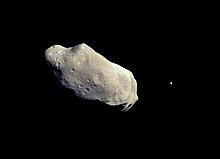
在此期間,地下冰會融化、加熱、溶解礦物質,然後將它們沉積在撞擊產生的裂縫或斷層中。對地球的研究記錄了產生的裂縫以及填塞在裂縫中的次生礦脈[24][25][26][27]。從環火星飛行衛星拍攝的圖像中檢測到了撞擊坑附近的裂縫[28];機遇號探測車在奮鬥撞擊坑邊緣發現了水相和低度熱蝕變區[29],這些區域靠近可讓深層流體循環的節理和裂縫附近,從而導致岩石產生化學和熱蝕變。因此,火星隕石坑周圍區域可能含有多樣由撞擊間接產生的礦物質[30]。
撞擊產生的熱量來自幾個過程,撞擊後,地面會立即反彈,導致較熱的岩石被抬升到地表,但,大部分的熱量是來自撞擊過程產生的動能。這種巨大的熱量在早期會產生出一些有用的礦品,然後繼續保持一段時間,它們被稱為「後生礦床」。撞擊裂縫中,富含礦物質的熱流體循環導致熱液作用,加拿大薩德伯里火成雜岩體中的銅鎳硫化物就是一則重要的事例。多年來,薩德伯里地區的礦石每年產生 20 億美元的價值,薩德伯里地層為我們提供了鋅、銅、金和鉛等礦石[25][31]。
一組研究奧基隕擊坑的科研人員報告了熱液作用的有力證據,該隕石坑中的脊線可能是在撞擊形成裂縫後產生的。他們利用火星勘測軌道飛行器上的儀器,發現了在地球上通常由撞擊引起的熱液系統中所見到的蒙脫石、二氧化矽、沸石、蛇紋石、碳酸鹽和綠泥石等礦石[32][33][34][35][36][37],其他研究火星隕石坑的科學家則提供了火星上撞後擊形成的熱液系統證據[38][39][40]。
-
背景相機顯示的奧基隕擊坑廣角視圖
-
高解像度成像科學設備顯示的奧基隕擊坑中部,箭頭指示了脊線位置,沙丘出現在圖像頂部附近。
-
上一幅高解像度成像科學設備圖像中的脊線近景圖,箭頭指示了一處「X」形脊線。
-
顯示了帶指示脊線箭頭的奧基隕擊坑中央部分近景,前一幅圖像的放大版。
火星表面有大量證據表明,過去濕潤的氣候,在今天凍結為地下冰;因而,很有可能通過撞擊加熱建立了熱液體系。美國宇航局的火星奧德賽號從軌道上使用伽馬射線光譜儀實際測量了冰的分佈[41]。在過去,大量的水可能在裂縫中循環並沉積出了新的礦物,在來自火星的隕石中發現了這種稱為熱液蝕變的作用。2011年2月發表的一項研究,詳細介紹了在一顆火星輝橄無球粒隕石礦脈中發現的粘土礦物、蛇紋石和碳酸鹽[42][43]。鳳凰號着陸器降落時的火箭引擎噴流實際暴露了一層冰,並看到了冰的融化(冰升華後消失)[44][45].
由於地球上大約180座隕石坑中有30%含有礦物或石油和天然氣,因此隕石坑似乎促進了自然資源的演變[46]。在地球上與撞擊有關作用產生的礦石包括鐵、鈾、金、銅和鎳礦等。 據估計,僅在北美,每年從撞擊結構中開採的礦物價值就高達50億美元[25]。
-
希臘盆地區地形圖,這是需要數千年才能冷卻的撞擊之一。在該地區冷卻過程中,可能沉積了大量的礦物。
-
阿耳古瑞盆地地形圖,阿耳古瑞區的主要特徵,這座巨大的撞擊坑也需要數千年的時間才能冷卻。
可用材料的直接證據
[編輯]
一段時間以來,科學界已認可了一群來自火星隕石,因此,它們代表了該行星的實際樣本,並已通過可用的最佳設備在地球上進行了分析。在這些被稱為SNC的隕石中,檢測到了許多重要元素,鎂、鋁、鈦、鐵和鉻等在其中較為常見。此外,還發現了微量的鋰、鈷、鎳、銅、鋅、鈮、鉬、鑭、銪、鎢和金。很有可能在某些地方,這些礦物的密集程度足以進行經濟開採[47]。
火星着陸器海盜1號、海盜2號、探路者路、機遇號探測車和勇氣號探測車在火星土壤中發現了鋁、鐵、鎂和鈦[48]。機遇號發現了一種名為「藍莓石」的赤鐵礦球核,這是一種主要的鐵礦石[49],這些藍莓石很容易被收集起來並還原成用於煉鋼的金屬鐵。

此外,「勇氣號」和「機遇號」探測車都在火星表面發現了鎳鐵隕石[50][51],它們也可用來製造鋼鐵[52]。
2011年12月,機遇號探測車發現了一道從土壤中突出的石膏礦脈,測試證實它含有鈣、硫和水.石膏礦物與探測數據最相符,它可能是由富含礦物質的水穿過岩石裂縫時所形成,這條名為「霍姆斯特克」礦脈位於火星子午線高原中,富含硫酸鹽的沉積基岩與奮鬥撞擊坑邊緣裸露的更老火山基岩的交匯區[53]。
-
熱盾岩—在另一顆行星上發現的第一顆隕石,它含有93%的鐵。

-
海盜號登陸器拍攝了這張火星表面照片並分析了土壤。
黑色沙丘在火星表面很常見,它們的黑色調是由一種叫做玄武岩的火山岩造所成。玄武岩沙丘被認為含有鉻鐵礦、磁鐵礦和鈦鐵礦等礦物[54]。由於風將它們聚集在一起,因此,它們甚至不必開採,直接挖取就可[55],這些礦物可為未來定居者提供鉻、鐵和鈦等材料。
-
高解像度成像科學設備拍攝的挪亞區沙丘全景圖
-
高解像度成像科學設備拍攝的上圖中的沙丘特寫,注意一些巨石上幾乎沒有覆蓋沙子。
未來火星礦石勘探
[編輯]從理論上講,火星上存在礦石資源[55],靈敏的探測設備可探知在何處找到它們,比如隕石坑周圍和火山附近。隨着拍攝圖像的增多,收集到的信息也將越益豐富,這將有助於更好地繪製較小結構的位置,如表明侵入(地表下)火成活動的岩脈。之後,載有重力和磁性測量裝置的無人飛行器將能地確定礦床的確切位置。
另請查看
[編輯]參考文獻
[編輯]- ^ Cordell, B. 1984. A Preliminary Assessment of Martian Natural Resource Potential. The Case For Mars II.
- ^ Clark, B. 1984. Chemistry of the Martian Surface: Resources for the Manned Exploration of Mars, in The Case For Mars. P. Boston, ed. American Astronautical Society. Univelt Inc. San Diego, CA
- ^ West, M., J. Clarke. 2010. Potential martian mineral resources: Mechanisms and terrestrial analogs. Planetary and Space Science 58, 574–582.ResearchGate (頁面存檔備份,存於互聯網檔案館)
- ^ 4.0 4.1 4.2 Larry O'Hanlon. Mining Mars? Where's Ore?. Discovery News. February 22, 2010 [2021-10-27]. (原始內容存檔於2012-10-22).
- ^ Namowitx, S. and D. Stone. 1975. Earth Science: The World We Live In. American Book Company. NY, NY.
- ^ Igneous Geochemistry (PDF). home.wlu.edu. (原始內容 (PDF)存檔於2016-06-11).
- ^ Hsu, Jeremy. What Are Rare Earth Elements?. Live Science. June 14, 2010.
- ^ Sorrell, C. 1973. Rocks and Minerals. Golden Press. NY, NY.
- ^ Patterson, Megan Elizabeth. Hydrothermal Alterations and the Formation of Metal Ores in the Sierra Nevada's. sierra.sitehost.iu.edu. 2003 [2021-08-02]. (原始內容存檔於2021-02-24).
- ^ California Gold Quartz Veins. Nevada Outback Gems. [2021-10-27]. (原始內容存檔於2021-08-27).
- ^ Laimin, Zhu. A study on the relations between Ultrabasic Dikes and fine disseminated gold deposits in southwestern Guizhou Province as exemplified by Zimudang large-sized gold deposit. Chinese Journal of Geochemistry. 1998, 17 (4): 362–371. S2CID 130661251. doi:10.1007/bf02837988.
- ^ Miranda Gold Corp. - Home Page - Fri Sep 28, 2018. www.mirandagold.com. [2021-10-27]. (原始內容存檔於2013-03-27).
- ^ Gries, John Paul. Roadside Geology of South Dakota. 1996. ISBN 0-87842-338-9.
- ^ Pirajno, F. 2004. Metallogeny in the Capricorn Orogen, Western Australia, the result of multiple ore-forming processes. Precambrian Research: 128. 411-439
- ^ David Susko, Suniti Karunatillake, Gayantha Kodikara, J. R. Skok, James Wray, Jennifer Heldmann, Agnes Cousin, Taylor Judice. "A record of igneous evolution in Elysium, a major martian volcanic province. Scientific Reports, 2017; 7: 43177 doi:10.1038/srep43177
- ^ Mars more Earth-like than moon-like: New Mars research shows evidence of a complex mantle beneath the Elysium volcanic province. ScienceDaily. February 24, 2017 [31 July 2021]. (原始內容存檔於2021-10-29).
- ^ Characteristics and Origin of Giant Radiating Dyke Swarms. MantlePlumes.org. [2021-10-27]. (原始內容存檔於2021-02-24).
- ^ Head, J. et al. 2006. The Huygens-Hellas giant dike system on Mars: Implications for Late Noachian-Early Hesperian volcanic resurfacing and climate evolution. Geology: 34. 285-288.
- ^ Goudy, C. and R. Schultz. 2005. Dike intrusions beneath grabens south of Arsia Mons, Mars. Geophysical Research Letters: 32. L05201
- ^ Mege, D. et al. 2003. Volcanic rifting at Martian grabens. Journal of Geophysical Research: 108.
- ^ Wilson, L. and J. Head. 2002. Tharsis-radial graben systems as the surface manifestation of plume-related dike intrusion complexes: Models and implications. Journal of Geophysical Research: 107.
- ^ Crisp, J. 1984. Rates of magma emplacement and volcanic output. J. Volcano. Geotherm. Res: 20. 177-211.
- ^ Ernst, R. 2007. large Igneous Provinces in Canada Through Time and Their Metallogenic Potential. Mineral Deposits of Canada: A Synthesis of Major Deposit-Types, District Metallogeny, the Evolution of Geological Provinces, and Exploration Methods: Geological Association of Canada, Mineral Division, Special Publication No. 5. 929-937.
- ^ Grieve, Richard; Masaitis, V. L. The Economic Potential of Terrestrial Impact Craters. International Geology Review. 1994, 36 (2): 105–151. doi:10.1080/00206819409465452.
- ^ 25.0 25.1 25.2 Grieve, R., V. Masaitis. 1994. The Economic Potential of Terrestrial Impact Craters. International Geology Review: 36, 105-151.
- ^ Osinski, G, J. Spray, and P. Lee. 2001. Impact-induced hydrothermal activity within the Haughton impact structure, Arctic Canada: Generation of a transient, warm, wet oasis. Meteoritics & Planetary Science: 36. 731-745
- ^ Pirajno, F. 2000. Ore Deposits and Mantle Plumes. Kluwer Academic Publishers. Dordrecht, The Netherlands
- ^ Head, J. and J. Mustard. 2006. Breccia Dikes and Crater-Related Faults in Impact Craters on Mars: Erosion and Exposure on the Floor of a 75-km Diameter Crater at the Dichotomy Boundary. Special Issue on Role of Volatiles and Atmospheres on Martian Impact Craters Meteoritics & Planetary Science
- ^ Arvidson, R., et al. 2015. Recent Results from the Opportunity Rover's Exploration of Endeavour Crater, Mars. 46th Lunar and Planetary Science Conference. 1118.pdf
- ^ Crumpler, L., R. Arvidson, W. Farrand, M. Golombek, J. Grant, D. Ming, D. Mittlefehldt, T. Parker. 2015. Opportunity In Situ Geologic Context of Aqueous Alteration Along Offsets in the Rim of Endeavour Crater. 46th Lunar and Planetary Science Conference. 2209.pdf
- ^ Grieve R., A. Therriault. 2000 Vredefort, Sudbury, Chicxulub: Three of a kind? Annual Review of Earth and Planetary Sciences 28: 305-338 Grieve
- ^ Carrozzo, F. et al. 2017. Geology and mineralogy of the Auki Crater, Tyrrhena Terra, Mars: A possible post-impact-induced hydrothermal system. 281: 228-239
- ^ Loizeau, D. et al. 2012. Characterization of hydrated silicate-bearing outcrops in Tyrrhena Terra, Mars: implications to the alteration history of Mars. Icarus: 219, 476-497.
- ^ Naumov, M. 2005. Principal features of impact-generated hydrothermal circulation systems: mineralogical and geochemical evidence. Geofluids: 5, 165-184.
- ^ Ehlmann, B., et al. 2011. Evidence for low-grade metamorphism, hydrothermal alteration, and diagenesis on Mars from phyllosilicate mineral assemblages. Clays Clay Miner: 59, 359-377.
- ^ Osinski, G. et al. 2013. Impact-generated hydrothermal systems on Earth and Mars. Icarus: 224, 347-363.
- ^ Schwenzer, S., D. Kring. 2013. Alteration minerals in impact-generated hydrothermal systems – Exploring host rock variability. Icarus: 226, 487-496.
- ^ Marzo, G., et al. 2010. Evidence for Hesperian impact-induced hydrothermalism on Mars. Icarus: 667-683.
- ^ Mangold, N., et al. 2012. Hydrothermal alteration in a late Hesperian impact crater on Mars. 43rd Lunar and Planetary Science. #1209.
- ^ Tornabene, L., et al. 2009. Parautochthonous megabreccias and possible evidence of impact-induced hydrothermal alteration in Holden crater, Mars. 40th LPSC. #1766.
- ^ Odyssey Finds Water Ice in Abundance Under Mars' Surface. NASA. May 28, 2002 [2021-10-27]. (原始內容存檔於2020-02-24).
- ^ Rare Meteorites Reveal Mars Collision Caused Water Flow. www.spaceref.com.[失效連結]
- ^ H. G. Changela and J. C. Bridges. Alteration assemblages in the nakhlites: Variation with depth on Mars. Meteoritics & Planetary Science, 2011 45(12):1847-1867 doi:10.1111/j.1945-5100.2010.01123.x
- ^ Rayl, A. J. S. Phoenix Scientists Confirm Water-Ice on Mars. The Planetary Society. Planetary Society. 2008-06-21 [2008-06-23]. (原始內容存檔於June 27, 2008).
- ^ NASA - NASA Phoenix Mars Lander Confirms Frozen Water. www.nasa.gov. [2021-10-27]. (原始內容存檔於2008-07-01).
- ^ Oldest known impact crater found. www.spaceref.com.[失效連結]
- ^ Hugh H. Kieffer. Mars. University of Arizona Press. 1992 [7 March 2011]. ISBN 978-0-8165-1257-7. (原始內容存檔於2017-03-12).
- ^ Fairen, A. et al. 2009. Nature: 459. 401-404.
- ^ Squyres, et al. 2004. The Opportunity Rover's Athena science investigation at Meridiani Planum. Science: 306. 1598-1703.
- ^ Rodionov, D. et al. 2005. An iron-nickel meteorite on Meridiani Planum: observations by MER Opportunity's Mossbauer Spectrometer, European Geosciences Union in Geophysical Research Abstracts: 7. 10242
- ^ Yen, A., et al. Nickel on Mars: constraints on meteoritic material at the surface. Journal of Geophysical Research-Planets: 111. E12S11
- ^ Landis, G. 2009. Meteoritic steel as a construction resource on Mars. Acta Astronautica: 64. 183-187.
- ^ NASA -
NASA Mars Rover Finds Mineral Vein Deposited by Water
. www.nasa.gov. [2021-10-27]. (原始內容存檔於2017-06-25).
- ^ Ruzicka, G. et al. 2001. Comparative geochemistry of basalts from the Moon, Earth, HED asteroid, and Mars: implications for the origin of the Moon. Geochimica et Cosmochimica ACTA: 65. 979-997.
- ^ 55.0 55.1 West, M. and J. Clarke. 2010. Potential martian mineral resources: Mechanisms and terrestrial analogs. Planetary and Space Science: 58. 574-582. ResearchGate (頁面存檔備份,存於互聯網檔案館)










